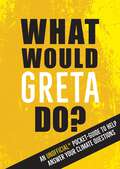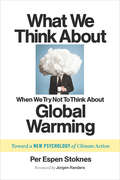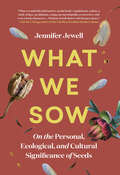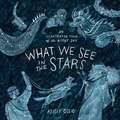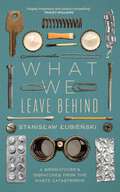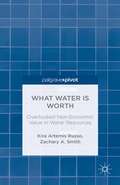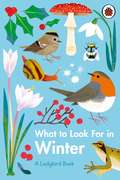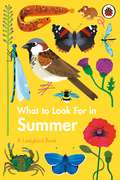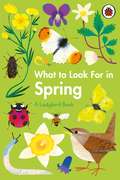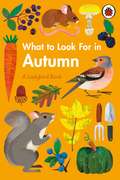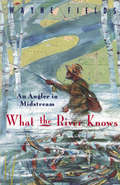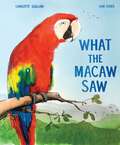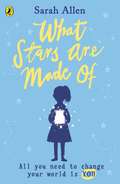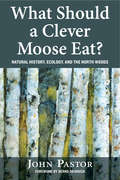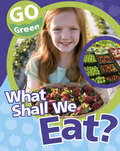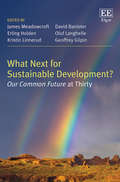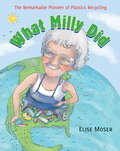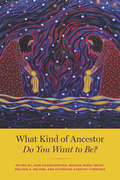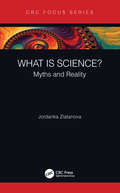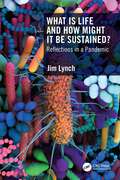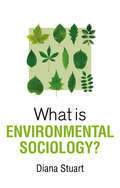- Table View
- List View
What Would Greta Do?: An Unofficial Pocket Guide to Help Answer Your Climate Questions
by Summersdale PublishersFrom your first steps toward living sustainably all the way to going zero-waste, this book is here to help you find solutions to all your climate conundrums by taking inspiration from a true eco-warrior. If we each approach the climate emergency in the same way as Greta, we can all live a planet-friendly life and enjoy a brighter future.
What Works in Conservation: 2021 (What Works in Conservation #6)
by William J. Sutherland;Lynn V. Dicks;Silviu O. Petrovan and Rebecca K. SmithDoes the creation of artificial reefs benefit subtidal benthic invertebrates? Is the use of organic farming instead of conventional farming beneficial to bat conservation? Does installing wildlife warning reflectors along roads benefit mammal conservation? Does the installation of exclusion and/or escape devices on fishing nets benefit marine and freshwater mammal conservation? What Works in Conservation has been created to provide practitioners with answers to these and many other questions about practical conservation. This book provides an assessment of the effectiveness of 2526 conservation interventions based on summarized scientific evidence. The 2021 edition containssubstantial new material on bat conservation, terrestrial mammal conservation and marine and freshwater mammals, thus completing the evidence for all mammal species categories. Other chapters cover practical global conservation of primates, amphibians, bats, birds, forests, peatlands, subtidal benthic invertebrates, shrublands and heathlands, as well as the conservation of European farmland biodiversity and some aspects of enhancing natural pest control, enhancing soil fertility, management of captive animals and control of freshwater invasive species. It contains key results from the summarized evidence for each conservation intervention and an assessment of the effectiveness of each by international expert panels. The accompanying website www.conservationevidence.com describes each of the studies individually, and provides full references. This is the fourth author-approved edition of What Works in Conservation, which is revised on an annual basis.
What We Think About When We Try Not To Think About Global Warming: Toward a New Psychology of Climate Action
by Per Espen Stoknes Jorgen RandersWhy does knowing more mean believing—and doing—less? A prescription for change The more facts that pile up about global warming, the greater the resistance to them grows, making it harder to enact measures to reduce greenhouse gas emissions and prepare communities for the inevitable change ahead. It is a catch-22 that starts, says psychologist and economist Per Espen Stoknes, from an inadequate understanding of the way most humans think, act, and live in the world around them. With dozens of examples—from the private sector to government agencies—Stoknes shows how to retell the story of climate change and, at the same time, create positive, meaningful actions that can be supported even by deniers. In What We Think About When We Try Not To Think About Global Warming, Stoknes not only masterfully identifies the five main psychological barriers to climate action, but addresses them with five strategies for how to talk about global warming in a way that creates action and solutions, not further inaction and despair. These strategies work with, rather than against, human nature. They are social, positive, and simple—making climate-friendly behaviors easy and convenient. They are also story-based, to help add meaning and create community, and include the use of signals, or indicators, to gauge feedback and be constantly responsive. Whether you are working on the front lines of the climate issue, immersed in the science, trying to make policy or educate the public, or just an average person trying to make sense of the cognitive dissonance or grapple with frustration over this looming issue, What We Think About When We Try Not To Think About Global Warming moves beyond the psychological barriers that block progress and opens new doorways to social and personal transformation.
What We Sow: On the Personal, Ecological, and Cultural Significance of Seeds
by Jennifer JewellAn insightful, personal, and timely exploration into the wonderful world of seeds. In What We Sow, Jennifer Jewell brings readers on an insightful, year-long journey exploring the outsize impact one of nature's smallest manifestations—the simple seed. She examines our skewed notions where "organic" seeds are grown and sourced, reveals how giant multinational agribusiness has refined and patented the genomes of seeds we rely on for staples like corn and soy, and highlights the efforts of activists working to regain legal access to heirloom seeds that were stolen from Indigenous peoples and people of color. Throughout, readers are invited to share Jewell's personal observations as she marvels at the glory of nature in her Northern California hometown. She admires at the wild seeds she encounters on her short daily walks and is amazed at the range of seed forms, from cups and saucers to vases, candelabras, ocean-going vessels, and airliners. What We Sow is a tale of what we choose to see and what we haven't been taught to see, what we choose to seed and what we choose not to seed. It urgently proves that we must work hard to preserve and protect the great natural diversity of seed.
What We See in the Stars: An Illustrated Tour of the Night Sky
by Kelsey OseidWhat We See in the Stars Kelsey Oseid is a richly illustrated guide to the myths, histories, and science of the celestial bodies of our solar system, with stories and information about constellations, planets, comets, the northern lights, and more. Combining art, mythology, and science, What We See in the Stars is a tour of the night sky through more than a hundred magical pieces of original art, all accompanied by text that weaves related legends and lore with scientific facts. This beautifully packaged book covers the night sky's most brilliant features such as constellations, the moon, the bright stars, and the visible planets, as well as less familiar celestial phenomena like the outer planets, nebulae, and deep space. Adults seeking to recapture the magic of youthful stargazing, younger readers interested in learning about natural history and outer space, and those who appreciate beautiful, hand-painted art will all delight in this charming book.
What We Leave Behind: A Birdwatcher's Dispatches from the Waste Catastrophe
by Stanislaw Lubienski"Everything looked perfect. Sand - unique Baltic sand, the best in the world - and the calm sea. But wait. Something was amiss. Something was wrong"It starts with a day at the beach. A single white sock that somehow spoils everything. It's enough to send writer and ornithologist Stanislaw Lubienski on a quest to understand what we throw away, where it goes and whether it will be our legacy. By analysing items he unearths on his trips into nature - a plastic bottle, a tube of Russian penis-enlargement cream, a cigarette butt, an empty aerosol can - tracing their origins and explaining the harm they can do, he shows how consumer society has developed out of control, to the point of environmental catastrophe.He also looks with a birdwatcher's eye at how various animals have come to adapt to and even rely on our rubbish, and interrogates the cultural significance of waste and the origins of our throw-away lifestyles. Finally, he adds a personal touch by examining his own "environmental neurosis" and by going out with refuse crews to watch them work.While Lubienski never hectors his readers, nor shames them, his clear-eyed, persuasive and humble polemic reminds us what we, as individuals, can and cannot do to address an apocalyptic issue while there's still something worth saving.Translated from the Polish by Zosia Krasodomska-Jones
What Water Is Worth: Overlooked Non-economic Value In Water Resources
by K. Russo Z. SmithWhat Water is Worth addresses both conventional and non-conventional values of water, discussing the value of water as it relates to conventional microeconomics, water's true utility and government regulation, and new and current practices in water management.
What to Look For in Winter
by Elizabeth JennerExplore the beauty of winter in this new edition of What to Look For in Winter.Despite the bare branches and long, dark nights, winter in the UK is a season full of life. The clear winter skies are filled with birds and the early morning frost reveals the tracks of nocturnal creatures. T his book takes a closer look at hoar frost, woodland fungi, clear starry skies and morning mists as the secrets of winter begin to appear in the world around us. Follow the changing seasons with the other titles in the What to Look For... series: What to Look For in SpringWhat to Look For in SummerWhat to Look For in Autumn
What to Look For in Summer (A\ladybird Book Ser.)
by Elizabeth JennerExplore the beauty of summer in this new edition of What to Look For in Summer.The increased warmth and long sunny days of summertime in the UK helps crops to grow, insects to thrive and animals to hunt. This book takes a closer look at ripening fruits, buzzing bees, summer storms and the solstice as the secrets of summer begin to appear in the world around us.Follow the changing seasons with the other titles in the What to Look For... series: What to Look For in AutumnWhat to Look For in WinterWhat to Look For in Spring
What to Look For in Spring
by Elizabeth JennerExplore the beauty of spring in this new edition of What to Look For in Spring.The natural world wakes from the long winter's sleep. Buds, blossoms and butterflies appear, marking the arrival of the season of rebirth. This book takes a closer look at bleating lambs, boxing hares, meteor showers and May Day celebrations as the secrets of the spring begin to appear in the world around us.Follow the changing seasons with the other titles in the What to Look For... series:What to Look For in SummerWhat to Look For in AutumnWhat to Look For in Winter
What to Look For in Autumn
by Elizabeth JennerExplore the beauty of autumn in this new edition of What to Look For in Autumn.In the UK, autumn is a season of change and preparation. The air temperature starts to drop, trees change colour and the days get shorter. This book takes a closer look at hedgerow picnics, unexpected houseguests and hibernating hedgehogs as the secrets of autumn begin to appear in the world around us.Follow the changing seasons with the other titles in the What to Look For... series: What to Look For in WinterWhat to Look For in SpringWhat to Look For in Summer
What the River Knows: An Angler in Midstream
by Wayne FieldsAt the age of forty-two, Wayne Fields set upon a sort of pilgrimage when he waded the near twenty-mile stretch of a small river in northern Michigan with fly rod in hand. He emerged with a beautiful and poignant memoir, a meditation on families and aging, and a whimsical response to what time, and streams, and those we care about bring into our lives.
What the Macaw Saw
by Charlotte GuillainTold in gentle rhyming verse, this beautiful non-fiction picture book follows the story of a flock of colourful macaws as they live their lives in the Amazon rainforest. Through the voice of one of the macaws, we hear about the bounty of the rainforest, as well as the challenges they have faced – threatened by the destruction of their home through machinery and forest fires to make room for vast plantations. Still, there are some areas where the land is protected and they can live a life of freedom among the trees... perhaps in the future, humans will learn the true value of the forest once again?Accompanying non-fiction pages at the end of the book include information on on endangered macaws, the importance of the rainforest, and the causes of deforestation, as well as what we can do to help.
What Stars Are Made Of
by Sarah AllenFrom the publishers who brought you Wonder, comes an astonishingly bold and moving middle-grade debut about family, friendship and how it's OK to be different. Libby wants to be a scientist when she grows up, just like her hero, the underrated astronomer Cecilia Payne. She'd also do anything for her family - and when her beloved big sister Nonny is in trouble, Libby comes up with the perfect plan to help her, and at the same time remind the world what stars are made of.
What Should a Clever Moose Eat?: Natural History, Ecology, And The North Woods
by JOHN PASTORJohn Pastor explores the natural history of the North Woods, an immense and complex forest that stretches from the western shore of Lake Superior to the far coast of Newfoundland. From the geological history of the region to the shapes of leaves and the relationship between aspens, caterpillars, and predators, Pastor delves into a fascinating range of topics as diverse as the North Woods themselves. Through his meticulous observations of the natural world, scientists and nonscientists alike learn to ask natural history questions and form their own theories, gaining a greater understanding of and love for the North Woods—and other natural places precious to them.
What Shall We Eat?: What Shall We Eat? (Go Green #4)
by Helen Lanz'Go Green: What Shall We Eat?' looks at how food reaches our table, and explains how careful shopping and planning can really cut down on the amount of food we waste.Packed with statistics, useful information and handy tips, each title in the tells us what steps we can all take to `go green`.
What Next for Sustainable Development?: Our Common Future at Thirty
by James Meadowcroft David Banister Erling Holden Oluf Langhelle Kristin LinnerudSustainable development brings together a series of normative themes related to negotiating environmental limits, to addressing equity, needs and development, and to the process of transformation and transition. To mark the thirtieth anniversary of Our Common Future (1987), that first placed sustainable development on the global agenda, the editors have brought together a group of international scholars from a range of social science backgrounds. They have discussed these same themes – looking backwards in terms of what has been achieved, assessing the current situation with respect to sustainable development, and looking forwards to identify the key elements of the future agenda. This book presents a series of critical reflections on these enduring themes. The overriding concern is with the present and with the future as the editors seek to explore the question: What next for sustainable development?
What Milly Did: The Remarkable Pioneer of Plastics Recycling
by Elise MoserThe extraordinary story of the woman who made plastics recycling possible. Milly Zantow wanted to solve the problem of her town’s full landfill and ended up creating a global recycling standard — the system of numbers you see inside the little triangle on plastics. This is the inspiring story of how she mobilized her community, creating sweeping change to help the environment. On a trip to Japan in 1978, Milly noticed that people were putting little bundles out on the street each morning. They were recycling — something that hadn’t taken hold in North America. When she returned to Sauk City, Wisconsin, she discovered that her town’s landfill was nearing capacity, and that plastic made up a large part of the garbage. No one was recycling plastics. Milly decided to figure out how. She discovered that there are more than seven kinds of plastic, and they can’t be combined for recycling, so she learned how to use various tests to identify them. Then she found a company willing to use recycled plastic, but the plastic would have to be ground up first. Milly and her friend bought a huge industrial grinder and established E-Z Recycling. They worked with local school children and their community, and they helped other communities start their own recycling programs. But Milly knew that the large-scale recycling of plastics would never work unless people could easily identify the seven types. She came up with the idea of placing an identifying number in the little recycling triangle, which has become the international standard. Milly's story is a glimpse into the early days of the recycling movement and shows how, thanks to her determination, hard work and community-building, huge changes took place, spreading rapidly across North America. Correlates to the Common Core State Standards in English Language Arts: CCSS.ELA-LITERACY.RI.3.3 Describe the relationship between a series of historical events, scientific ideas or concepts, or steps in technical procedures in a text, using language that pertains to time, sequence, and cause/effect. CCSS.ELA-LITERACY.RI.4.7 Interpret information presented visually, orally, or quantitatively (e.g., in charts, graphs, diagrams, time lines, animations, or interactive elements on Web pages) and explain how the information contributes to an understanding of the text in which it appears.
What Kind of Ancestor Do You Want to Be?
by John Hausdoerffer Brooke Parry Hecht Melissa K. Nelson Katherine Kassouf CummingsAs we face an ever-more-fragmented world, What Kind of Ancestor Do You Want to Be? demands a return to the force of lineage—to spiritual, social, and ecological connections across time. It sparks a myriad of ageless-yet-urgent questions: How will I be remembered? What traditions do I want to continue? What cycles do I want to break? What new systems do I want to initiate for those yet-to-be-born? How do we endure? Published in association with the Center for Humans and Nature and interweaving essays, interviews, and poetry, this book brings together a thoughtful community of Indigenous and other voices—including Linda Hogan, Wendell Berry, Winona LaDuke, Vandana Shiva, Robin Kimmerer, and Wes Jackson—to explore what we want to give to our descendants. It is an offering to teachers who have come before and to those who will follow, a tool for healing our relationships with ourselves, with each other, and with our most powerful ancestors—the lands and waters that give and sustain all life.
What Kind of Ancestor Do You Want to Be?
As we face an ever-more-fragmented world, What Kind of Ancestor Do You Want to Be? demands a return to the force of lineage—to spiritual, social, and ecological connections across time. It sparks a myriad of ageless-yet-urgent questions: How will I be remembered? What traditions do I want to continue? What cycles do I want to break? What new systems do I want to initiate for those yet-to-be-born? How do we endure? Published in association with the Center for Humans and Nature and interweaving essays, interviews, and poetry, this book brings together a thoughtful community of Indigenous and other voices—including Linda Hogan, Wendell Berry, Winona LaDuke, Vandana Shiva, Robin Kimmerer, and Wes Jackson—to explore what we want to give to our descendants. It is an offering to teachers who have come before and to those who will follow, a tool for healing our relationships with ourselves, with each other, and with our most powerful ancestors—the lands and waters that give and sustain all life.
What is Science?: Myths and Reality
by Jordanka ZlatanovaIn a multitude of ways, science affects the life of almost every person on earth. From medicine and nutrition to communication and transportation, the products of scientific research have changed human life. These changes have mostly taken place in the last two centuries, so rapidly that the average person is unable to keep informed. A consequence of this "information gap" has been the increasing suspicion of science and scientists. The lack of true understanding of science, especially of "fundamental" research, motivates this effort to narrow this gap by explaining scientific endeavor and the data-driven worldviews of scientists. Key Features Fills an existing void in the understanding of science among the general population Is written in a nontechnical language to facilitate understanding Covers a wide range of science-related subjects: The value of "basic research" How scientists work by sharing results and ideas How science is funded by governments and private entities Addresses the possible dangers of research and how society deals with such risks Expresses the viewpoint of an author with extensive experience working in laboratories all over the world
What is Science?: Myths and Reality
by Jordanka ZlatanovaIn a multitude of ways, science affects the life of almost every person on earth. From medicine and nutrition to communication and transportation, the products of scientific research have changed human life. These changes have mostly taken place in the last two centuries, so rapidly that the average person is unable to keep informed. A consequence of this "information gap" has been the increasing suspicion of science and scientists. The lack of true understanding of science, especially of "fundamental" research, motivates this effort to narrow this gap by explaining scientific endeavor and the data-driven worldviews of scientists. Key Features Fills an existing void in the understanding of science among the general population Is written in a nontechnical language to facilitate understanding Covers a wide range of science-related subjects: The value of "basic research" How scientists work by sharing results and ideas How science is funded by governments and private entities Addresses the possible dangers of research and how society deals with such risks Expresses the viewpoint of an author with extensive experience working in laboratories all over the world
What Is Life and How Might It Be Sustained?: Reflections in a Pandemic
by Jim LynchHow did the universe and life begin and what are the threats to people and the environment in a pandemic? This book is for anybody with interest in protecting life on the planet. Studies on the origin of life and scientific contributions to safeguarding the planet are examined in light of current thinking on climate change. A major focus is the spread of microbes, put in the context of environmental assessment and management, including descriptions of microbiomes and a consideration of the risks of genetic modifications. Professor Lynch shows how failure to control disease can lead to the collapse of any biotic population. To avoid this, the ethics of management of disease by biological control and by vaccination are discussed, at the practical level and in a moral theological context.
What Is Life and How Might It Be Sustained?: Reflections in a Pandemic
by Jim LynchHow did the universe and life begin and what are the threats to people and the environment in a pandemic? This book is for anybody with interest in protecting life on the planet. Studies on the origin of life and scientific contributions to safeguarding the planet are examined in light of current thinking on climate change. A major focus is the spread of microbes, put in the context of environmental assessment and management, including descriptions of microbiomes and a consideration of the risks of genetic modifications. Professor Lynch shows how failure to control disease can lead to the collapse of any biotic population. To avoid this, the ethics of management of disease by biological control and by vaccination are discussed, at the practical level and in a moral theological context.
What is Environmental Sociology? (What is Sociology?)
by Diana StuartGiven the escalating and existential nature of our current environmental crises, environmental sociology has never mattered more. We now face global environmental threats, such as climate change and biodiversity loss, as well as local threats, such as pollution and household toxins. The complex interactions of such pervasive problems demand an understanding of the social nature of environmental impacts, the underlying drivers of these impacts, and the range of possible solutions. Environmental sociologists continue to make indispensable contributions to this crucial task. This compact book introduces environmental sociology and emphasizes how environmental sociologists do “public sociology,” that is, work with broad public application. Using a diversity of theoretical approaches and research methods, environmental sociologists continue to give marginalized people a voice, identify the systemic drivers of our environmental crises, and evaluate solutions. Diana Stuart shines a light on this work and gives readers insight into applying the tools of environmental sociology to minimize impacts and create a more sustainable and just world.
